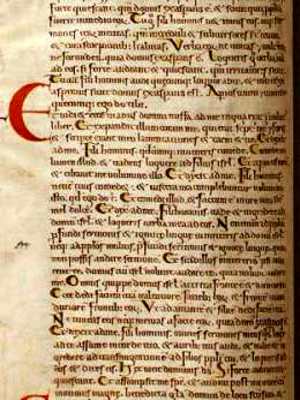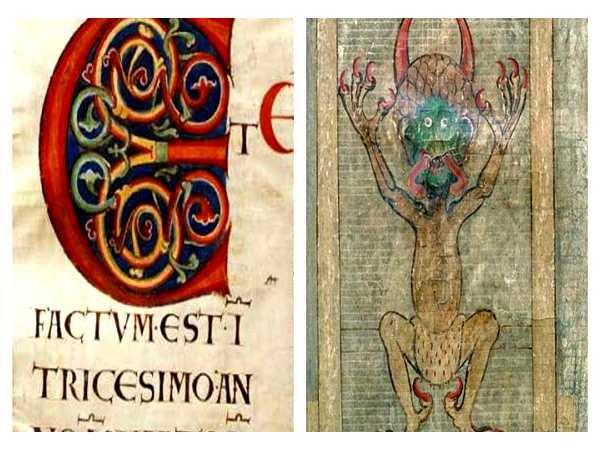The Codex Gigas, also known as “The Devil’s Bible,” stands as one of the most intriguing and mysterious artifacts from the medieval era. This massive manuscript, measuring nearly 3 feet long and weighing over 160 pounds, is the largest known medieval manuscript in existence. Written in the early 13th century, it has captivated historians, scholars, and occult enthusiasts for centuries due to its sheer size, mysterious origins, and striking full-page illustration of the devil himself.
But what makes the Codex Gigas so fascinating? Is it merely an oversized book, or does it hide darker secrets within its pages? In this article, we will delve into the history, content, and legends surrounding the Codex Gigas, while exploring the impact this enigmatic manuscript has had on both scholarly research and popular culture.
The Origins of the Codex Gigas
The Codex Gigas was created in the early 13th century, likely in a Benedictine monastery in what is now the Czech Republic. Though the manuscript’s precise origins remain unclear, it is widely believed to have been written by a monk named Herman the Recluse. According to legend, Herman broke his monastic vows and was sentenced to be walled up alive as punishment. To avoid this gruesome fate, he promised to create a book that would contain all human knowledge in one night. Realizing he could not complete the task alone, Herman allegedly made a pact with the devil, who helped him finish the book in exchange for his soul.
Whether or not this legend holds any truth, the fact remains that the Codex Gigas is a marvel of medieval craftsmanship. Written in Latin, the manuscript contains over 600 pages of vellum made from calfskin, which would have required the hides of over 160 animals. Its creation likely took decades to complete, suggesting it was the work of many hands rather than a single monk. Despite its enormous size, the writing is incredibly uniform, indicating a meticulous and highly skilled process.
The Content of the Codex Gigas
The Codex Gigas is not just an oversized Bible; it is a compendium of medieval knowledge that includes religious texts, historical accounts, medical treatises, and magical formulas. Its diverse content reflects the interests and concerns of the medieval world, blending religious devotion with scientific inquiry and occult practices.

Religious Texts
At its core, the Codex Gigas contains the complete Latin Bible, including both the Old and New Testaments. However, it also features additional religious texts, such as The Antiquities of the Jews by the Jewish historian Flavius Josephus and the Etymologiae by Isidore of Seville. These texts provide historical and theological context for the Bible, offering readers a comprehensive understanding of both scripture and the world in which it was written.
Historical Accounts
In addition to religious texts, the Codex Gigas includes several historical chronicles that document the history of the world from its creation to the medieval period. One of the most significant of these is the Chronica Bohemorum, a history of the Czech lands written by Cosmas of Prague. This chronicle provides valuable insight into the political and social landscape of medieval Europe, particularly in the regions surrounding the monastery where the manuscript was likely created.
Medical Treatises
The Codex Gigas also contains a number of medical treatises, reflecting the medieval belief in the close relationship between science, religion, and the supernatural. These treatises include descriptions of various diseases, herbal remedies, and medical procedures, offering a glimpse into the medical practices of the time. Interestingly, the manuscript also includes magical formulas and incantations, blurring the line between medicine and magic in medieval thought.
The Devil’s Portrait
Perhaps the most famous and striking feature of the Codex Gigas is its full-page illustration of the devil, which has earned it the nickname “The Devil’s Bible.” This unsettling image shows the devil in a crouched position, with green skin, red-tipped horns, and a malevolent expression. The portrait is one of the few illustrations in the manuscript, standing in stark contrast to the religious and scholarly content that surrounds it. Its presence has fueled speculation about the manuscript’s connection to the occult and has contributed to its enduring mystique.
The Legend of the Devil’s Pact
The legend of the Codex Gigas and its connection to the devil has persisted for centuries, largely due to the presence of the devil’s portrait and the mysterious circumstances surrounding the manuscript’s creation. According to the legend, the monk who created the manuscript turned to the devil out of desperation when he realized he could not complete the book on his own. In exchange for his soul, the devil helped him finish the manuscript in a single night, leaving his portrait behind as a signature.
While this story is likely apocryphal, it has become an integral part of the manuscript’s identity. The image of the devil, combined with the manuscript’s immense size and mysterious origins, has given rise to countless theories about its purpose and meaning. Some believe the Codex Gigas was created as a grimoire, a book of magic and spells, while others see it as a symbol of the eternal struggle between good and evil.
The Journey of the Codex Gigas
The Codex Gigas has had a long and storied journey since its creation in the 13th century. For much of its early life, the manuscript remained in the possession of the Benedictine monastery where it was created. However, during the Thirty Years’ War in the 17th century, Swedish forces captured the manuscript and brought it to Stockholm, where it has remained ever since. Today, it is housed in the National Library of Sweden, where it continues to attract visitors from around the world.
Despite its age and the wear and tear of centuries, the Codex Gigas remains remarkably well-preserved. Scholars have studied its content extensively, and while many of its mysteries have been uncovered, others continue to elude even the most diligent researchers. The manuscript’s combination of religious texts, historical accounts, medical treatises, and occult symbolism makes it a unique window into the medieval mind and its complex relationship with knowledge, faith, and the supernatural.
Decoding the Codex Gigas: Theories and Interpretations
The Codex Gigas has sparked numerous interpretations over the centuries, ranging from the scholarly to the mystical. Some historians see it as a symbol of the medieval pursuit of universal knowledge, a book that sought to encapsulate all that was known about religion, history, and science. Others interpret the manuscript’s blend of religious and occult imagery as evidence of the tension between Christianity and older pagan beliefs, a tension that was still very much alive in the medieval period.
The presence of the devil’s portrait, in particular, has inspired a range of theories. Some scholars believe that the portrait was intended as a warning against the dangers of pride and hubris, a reminder of the consequences of turning away from God. Others see it as an allegory for the monk’s struggle with his own inner demons, a visual representation of the temptations and fears that haunted him as he worked on the manuscript.
The manuscript’s medical content has also led some to speculate that the Codex Gigas was created as a reference book for both spiritual and physical healing. The inclusion of both medical treatises and magical formulas suggests that the line between science and magic was not as clearly defined in the medieval period as it is today. For the people of the time, the pursuit of knowledge encompassed both the natural and supernatural worlds, and the Codex Gigas reflects this holistic approach.
The Impact of the Codex Gigas on Popular Culture
The Codex Gigas has had a lasting impact on popular culture, particularly in the realms of horror fiction and conspiracy theories. Its nickname, “The Devil’s Bible,” has inspired numerous books, films, and television shows that explore the darker side of the manuscript’s legend. In recent years, the manuscript has been featured in documentaries and television specials, where its mysterious origins and sinister imagery continue to captivate audiences.
Beyond the realm of entertainment, the Codex Gigas has also become a subject of serious academic study. Scholars from a variety of disciplines, including history, theology, and cryptography, have examined the manuscript in an attempt to uncover its secrets. While much has been learned about the Codex Gigas, its origins and purpose remain shrouded in mystery, ensuring that it will continue to inspire curiosity and speculation for generations to come.
Conclusion
The Codex Gigas stands as a testament to the medieval world’s quest for knowledge and its fascination with both the divine and the diabolical. Its combination of religious devotion, historical scholarship, and occult symbolism makes it one of the most unique and enigmatic manuscripts in existence. Whether viewed as a monument to human achievement or as a relic of darker, more mysterious forces, the Codex Gigas continues to captivate and confound those who encounter it.

